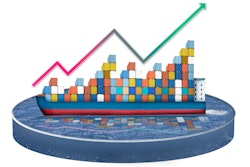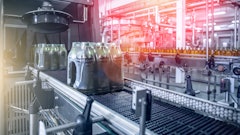![Getty Images 927114160 [converted]](https://img.sdcexec.com/files/base/acbm/sdce/image/2018/03/GettyImages_927114160__Converted_.5ab5343bdfa3b.png?auto=format%2Ccompress&q=70&w=400)
While implementing Internet of Things (IoT) technology into a supply chain can yield extremely powerful insights, it is not without its challenges. The constant stream of data from hundreds or even thousands of sources must be accurately captured and analyzed. Further, the same word of caution commonly uttered by investment professionals, that past performance will not guarantee future results, is also applicable for supply chain operations.
Simply capturing and looking backwards at data to try to act on the results is not good enough, nor is it sustainable or the best use of planning time. A supply chain planning and optimization solution needs to be capable of delivering robust planning that also analyzes IoT data for predictive and prescriptive analytics.
Once it’s decided how to handle the available data, consider the data quality issues that could arise. At the same time, don’t wait for IoT data to be perfect. Doing so can prevent the supply management team from moving forward. This highlights the importance of being prepared to manage fuzzy or imperfect data.
Data, Piece by Piece
Integrating IoT into the supply chain can also change how data is examined and understood. In the past, practitioners would typically develop a theory and set out to acquire data in an attempt to validate it. They would look at the data expecting to find a certain link and use the data gathered from IoT to confirm their hypothesis. Once proven, they would move forward with planning based on the validated assumptions.
A new way to look at data is that every piece has value and should be proactively utilized, rather than be available for reactive analysis. If practitioners embrace as much data as they can gather through IoT, it provides more opportunities to utilize machine learning algorithms in order to proactively mine data for insights. The algorithms may highlight a relationship between pieces of data that were not previously connected.
Modern computers running machine learning algorithms have the capacity to consider and test millions of possibilities that the human brain could never consider in fractions of a second. Ultimately, today’s supply chain professionals are still the gatekeepers for validating assumptions, but they need to be open to new ways of working to allow the proactive analysis and output of machine learning algorithms to fully maximize efficient supply chain operations.
The ability to take in this much data from the supply chain allows practitioners to widen their perspective. In general, there is quite a bit about interconnectivity of supply chain processes that we don’t understand or have not connected because we haven’t had the data or ability to do that.
Understand Your Data for Better Results
Before determining that machine learning is a magic bullet for solving a supply chain puzzle, there needs to be some understanding of the data you’re working with in order to know what machine learning approach to take. Typically, there are three major categories of machine learning algorithms that are important to consider in supply chain planning.
- Supervised learning algorithm. In this case, practitioners would have data with known inputs and known outputs and use a supervised learning algorithm to determine the relationship between them and extract it to apply toward future planning.
- Unsupervised learning algorithm. This is used for data that is unlabeled, meaning there is some uncertainty surrounding what the data represents. Supply chain practitioners would use this algorithm to find hidden relationships in the data to highlight new patterns. This allows practitioners to take in as much data as possible and have the unsupervised learning algorithm organize it in a more meaningful way. A good example would be attempting to solve a 1,000-piece puzzle where every puzzle piece was colored black. This would be a very difficult puzzle to solve manually but unsupervised learning algorithms could determine what pieces are interconnected.
- Reinforcement learning algorithm. These types of algorithms were designed to optimize decisions where feedback is not provided immediately, but only at a future point in time. Bottlenecks in interconnected supply chain operations can be both difficult to identify and mitigate with planning changes. Reinforcement learning algorithms are perfectly suited to assist in both of these difficult tasks when provided the correct data.
For many supply chain puzzles, IoT data affords the opportunity to run multiple types of machine learning algorithms. For example, practitioners may run an unsupervised algorithm as a preprocessing step to a supervised algorithm. In this case, the unsupervised learning algorithm can identify outliers quickly through clustering techniques and assign them a lower weighting so they do not influence the outcome as much as other data points. Unsupervised learning algorithms can also remove variables, and their associated noise, that do not influence the outcomes at all through dimensionality reduction techniques. After unsupervised learning runs, the amount of fuzzy or imperfect data is greatly reduced and higher quality data can be passed to a supervised learning algorithm for a higher quality result.
Navigating through data noise and improving data quality becomes more difficult when you have two pieces of data with all of the same inputs but different outputs. In this case, practitioners would need to determine the interaction with other data points that could have influenced a different outcome from the same inputs. The more complex results require a good understanding of machine learning algorithms and that they work with a strong, flexible solution.
Imagine that the production plan is exactly the same on Monday and Tuesday, but Tuesday’s production is late. There are relationships that can cause this that we cannot understand without using machine learning data to reveal the relationship so we can better understand how to structure our planning and avoid delays. For example, with the production of industrial gases, the temperature of the surrounding environment has a dramatic impact on production levels. Therefore, the time of day, equipment and process can all be the same, but a minor change in external temperature will cause a variation in production levels.
With IoT, it doesn’t require an understanding of all of the data collected because the algorithms will assist in determining what is important and what is not. Going back to the example of industrial gas production, practitioners will learn what influences production, whether it is the time of day, temperature or even what was in the tank prior to this production.
IoT is very powerful, and layering machine learning algorithms to build complex layers of data enables practitioners to dig in and figure out what has happened and why, leading to a continuous improvement in planning.




















